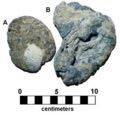Calcareous sponge
| Calcareous Sponge |
|---|

|
| Scientific Classification |
| Orders |
|
Calcareous Sponges are one of the three branches of the Phylum Porifera. These organisms are sessile creatures that can reproduce by both asexual and sexual methods. One of the most amazing aspects of the Calcareous Sponges is that it is able to regenerate a piece of an already grown and matured adult into a completely new organism.
Anatomy
Calcareous Sponges can come in many different shapes such as a purse, vase, pear, or some other sort of cylindrical shape. Calcareous Sponges lack the hollow cores that most other sponges have, but this makes the sponge stronger. The size of these particular sponges range from about an inch to about 12 in. This species is usually colorless but can be bright yellow, a greenish-brown color, or a red- yellow.

Calcarea Sponges are known as well as characterized by their spicules which are made out of calcium carbonate. Overlapping spicules provide the sponge with structural support and is considered a type of endoskeleton. Although most sponges are known for their three point spicules, Calcareous sponges may be four-pointed. Most Calcareous Sponges have a superficial radial symmetry.
Reproduction
Calcareous Sponges reproduce asexually by regeneration and through the process of budding. Both are a type of reproduction that results in a genetic clone. In the case of budding, the sponges produce a cluster of cells known as a gemmule that is covered in a hard coating, which keeps the offspring protected from harsh weather as well as climate changes. Regeneration is the ability of a sponge to grow a totally new and complete adult from a small piece of the adult sponge that has been torn loose. This process is used for commercial reasons as well. Although Calcareous sponges are asexual reproducing organism, they are also able to reproduce sexually.[1]
Ecology
There are approximately 150 known species of Calcareous Sponges. Calcareous Sponges live in shallow water and are exclusively found in marine environments. These particular organisms are what it commonly know as filter feeders. Although the sponges are sessile they can be found all over the globe, in every ocean and sea. Because Calcareous Sponges are filter feeders, their diet usually consists of particulates found in the water as well as many microscopic organic materials.[2]
Gallery
Calcareous Sponge - from Ernst Haeckel's Kunstformen der Natur (1904),
 Browse |
Related References
- Calcareous sponge Wikipedia
- Calcareous sponges Info please
- Ecology of sponges Berkely College
- Calcarea Answers


